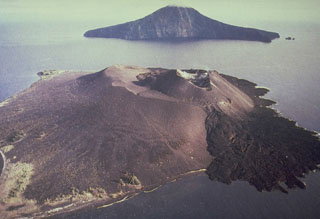Report on Krakatau (Indonesia) — May 1999
Bulletin of the Global Volcanism Network, vol. 24, no. 5 (May 1999)
Managing Editor: Richard Wunderman.
Krakatau (Indonesia) Occasional explosions producing ash columns
Please cite this report as:
Global Volcanism Program, 1999. Report on Krakatau (Indonesia) (Wunderman, R., ed.). Bulletin of the Global Volcanism Network, 24:5. Smithsonian Institution. https://doi.org/10.5479/si.GVP.BGVN199905-262000
Krakatau
Indonesia
6.1009°S, 105.4233°E; summit elev. 285 m
All times are local (unless otherwise noted)
Following several months of intense activity that began on 5 February (BGVN 24:04), Anak Krakatau became relatively quiet in late April. From the end of April until the end of May, only several explosions were heard. On 26 April a weak explosion sent a white-gray ash plume 200-500 m high. Between 4 and 17 May there were two blasts per week, each accompanied by a glow and white-gray ash reaching between 100 and 400 m high. In the week from 18 to 24 May, in addition to two explosions, a shock on the morning of 20 May registered at 2 on the MMI scale.
Anak Krakatau was very active from 1992 to 1997, depositing 6.8 x 106 m3 of lava flows. The island was enlarged by 378,527 m2 and the height of the cone increased from 159 to ~300 m.
Geological Summary. The renowned Krakatau (frequently mis-named as Krakatoa) volcano lies in the Sunda Strait between Java and Sumatra. Collapse of an older edifice, perhaps in 416 or 535 CE, formed a 7-km-wide caldera. Remnants of that volcano are preserved in Verlaten and Lang Islands; subsequently the Rakata, Danan, and Perbuwatan cones were formed, coalescing to create the pre-1883 Krakatau Island. Caldera collapse during the catastrophic 1883 eruption destroyed Danan and Perbuwatan, and left only a remnant of Rakata. This eruption caused more than 36,000 fatalities, most as a result of tsunamis that swept the adjacent coastlines of Sumatra and Java. Pyroclastic surges traveled 40 km across the Sunda Strait and reached the Sumatra coast. After a quiescence of less than a half century, the post-collapse cone of Anak Krakatau (Child of Krakatau) was constructed within the 1883 caldera at a point between the former Danan and Perbuwatan cones. Anak Krakatau has been the site of frequent eruptions since 1927.
Information Contacts: Volcanological Survey of Indonesia (VSI), Jalan Diponegoro No. 57, Bandung 40122, Indonesia (URL: http://www.vsi.esdm.go.id/).

